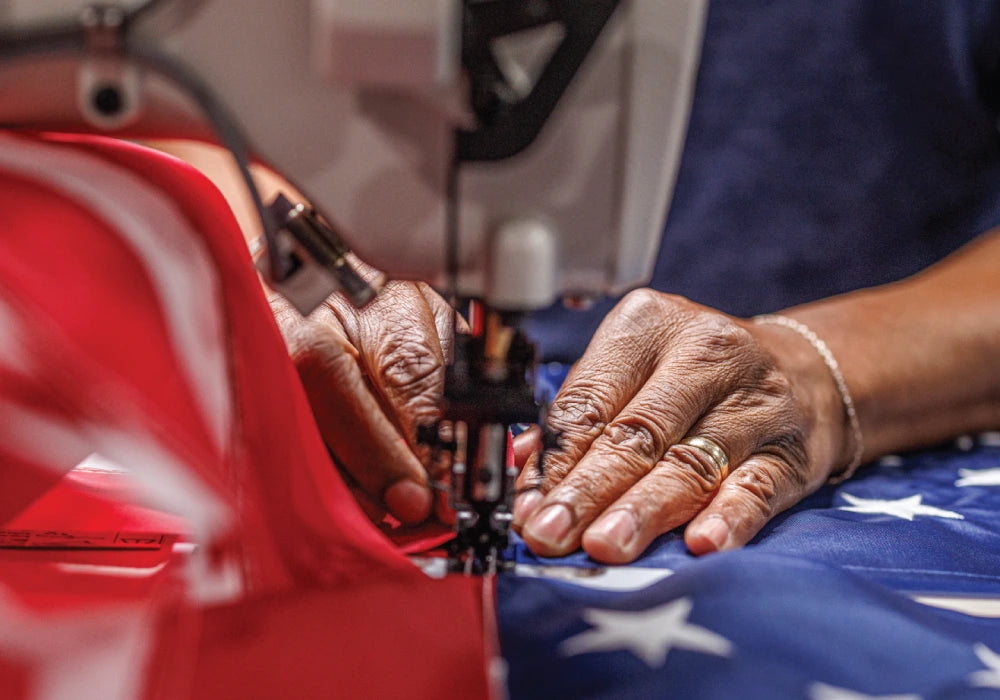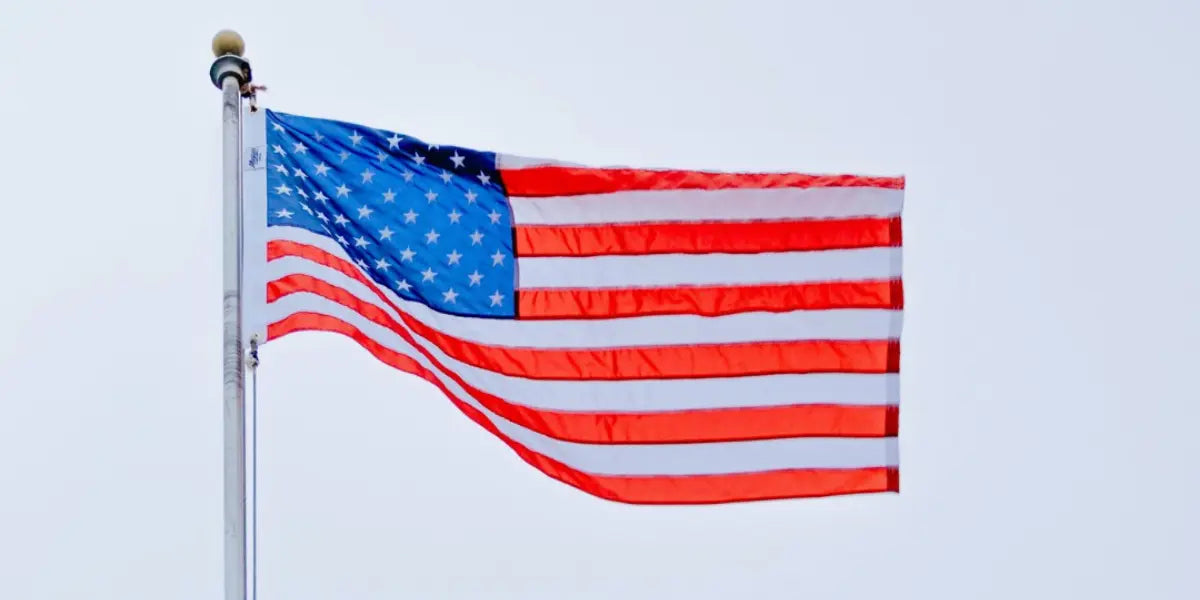Americans take great pride in their flag as a symbol of national identity and values, and over half of U.S. households display the Stars and Stripes at home. But what if the Stars and Stripes flying in front of your house wasn’t made on American soil? For those seeking made-in-USA flags, understanding what sets them apart from cheaper imports is crucial. In 2017 alone, roughly 10 million American flags were imported into the United States, and all but 50,000 of those came from China. This surprising fact raises an important question: does it matter where an American flag is made? The short answer for many patriotic consumers is “yes.” To some, flying a U.S. flag that was manufactured abroad just doesn’t sit right. It feels like it undercuts the very symbol of patriotism. A flag that’s made domestically often carries intangible qualities of pride and authenticity in addition to tangible differences in craftsmanship and quality. From superior materials and workmanship to compliance with U.S. flag standards, American flags made in the USA tend to stand out.

Patriotism and Symbolism: Why Origin Matters
When it comes to the American flag, its origin is deeply tied to the flag’s symbolism. Shoppers scanning through patriotic flags for sale often deliberately seek out those with a “Made in USA” label, precisely because of what the flag represents. The flag is more than fabric; it stands for national ideals and hard-won freedoms. Many people believe that having it manufactured by fellow Americans lends it an added layer of authenticity and respect.
This perspective is part of a broader trend of favoring American-made flag products. Even U.S. lawmakers have echoed this sentiment. Recent legislation now requires flags purchased by federal agencies to be entirely made in the United States, underscoring that the integrity of the symbol should be upheld through domestic craftsmanship. The very idea of an emblem of American pride being mass-produced overseas can be jarring. There’s a sense of pride in owning a flag that was born in the same country it represents. The knowledge that your banner was sewn and assembled by American hands adds emotional weight each time it’s raised on a pole or folded at a ceremony. The very legend of Betsy Ross sewing the first flag in 1777 underscores how ingrained the notion of a home-crafted flag is in American tradition.
Quality and Craftsmanship: Made in USA vs. Imported Flags
One major factor that sets American-made flags apart is the level of quality and craftsmanship. In a typical U.S. flag factory, each flag undergoes a meticulous assembly process. High-quality flags made in America differ from cheaper imports in several ways:
-
Material Strength: Domestic manufacturers use robust fabrics that are designed to withstand sun, wind, and rain. In contrast, many imported flags are made from thinner, low-denier polyester, which can feel flimsy and wear out more quickly.
-
Stitching and Details: American-made flags usually feature embroidered stars and individually sewn stripes, with lock-stitched seams and reinforced edges to prevent fraying. By comparison, imported flags often cut corners – for example, printing the star field and stripes on one piece of fabric, using fewer rows of stitching, and omitting reinforcements on the fly end.
-
Compliance and Labeling: Every flag made in the USA includes a label identifying it as “Made in USA,” by federal law. Premium flag makers also adhere to strict specifications for design proportions and colors. Cheaper foreign-made flags might not meet all official specifications, and some even lack proper origin markings or come with misleading packaging.
-
Longevity: Thanks to better materials and workmanship, a flag made in the USA will typically last significantly longer under the same conditions. The colors tend to stay vibrant longer, and the fabric and seams hold up better against tearing. Inexpensive imports, on the other hand, often fade quickly and may start to unravel after only a short time outdoors.
It’s little wonder, then, that the best USA flags on the market are those produced by reputable American manufacturers. Their superior construction means you won’t have to replace the flag as frequently, and you can fly it proudly knowing it was built to a high standard.
Materials and Durability: Nylon, Polyester, or Cotton?
Not all flags are made of the same cloth, literally. Modern American flags typically come in three main fabric options, each with different characteristics. Choosing the right material can significantly impact how long a flag lasts and how well it performs in various conditions.
-
Nylon: Nylon is the most common material for U.S. flags and is popular for good reason. It’s lightweight and catches even a slight breeze, so a nylon flag will flutter nicely even on a calm day. It also absorbs dye well, yielding rich, vibrant colors that stand out. Significantly, nylon flags dry quickly after rain and resist mildew. Standard nylon flags (often 200-denier fabric) offer a balance of durability and affordability for everyday outdoor display in moderate climates.
-
Polyester: A heavy-duty polyester flag (typically made from 2-ply spun polyester) is ideal for high-wind areas and continuous outdoor use. The thicker fabric can handle strong gusts and sustained sunlight with less wear. Polyester flags are known to be the most durable overall – they are far less likely to rip or fray in severe weather, making them perfect for commercial or 24/7 applications. The trade-off is that polyester flags are heavier, so they require a stiffer breeze to fly well, and they tend to be slightly more expensive. Many government buildings and businesses choose polyester for its longevity, whereas home users might opt for it if their location sees frequent storms or high winds.
-
Cotton: Cotton was the traditional flag material in earlier eras and is still used today for indoor or ceremonial flags. A cotton flag has a classic, matte appearance and a substantial feel, which many people find elegant for display on special occasions or holidays. However, cotton is not as durable outdoors – it fades under UV light, and the fibers can absorb water, becoming heavy and prone to mildew. Because of this, cotton U.S. flags are best reserved for short-term outdoor use or for indoor settings. Many veterans’ burial flags, for instance, are made of cotton for its traditional look, but they are not meant to withstand daily flying.
Material matters: if you want the flag to fly proudly day in and day out, a sturdy nylon or polyester flag from a reputable American manufacturer is the best bet. For most homes, nylon works great, while in extreme conditions, a polyester flag will last the longest. For truly harsh conditions, a two-ply polyester banner is widely regarded as the best outdoor American flag choice due to its superior strength and longevity.
Standards and Certification: Ensuring a Flag Is Truly American-Made
Purchasing a flag that is advertised as “Made in the USA” doesn’t have to be a leap of faith – there are concrete ways to verify that you’re getting genuine U.S.-made flags. First, check the physical flag or its packaging for a label indicating the country of origin. U.S. law requires that flags include a label such as “Made in USA” or “Made in China,” so this is the most basic proof of origin. If a flag is missing this tag or if the labeling is ambiguous, that’s a red flag that it may not be truly American-made.

Beyond the standard labeling, an additional layer of assurance is available for quality American flags. The Flag Manufacturers Association of America (FMAA) operates a “Certified Made in the USA” program, which ensures that a flag has been manufactured entirely with American-sourced materials and American labor, with compliance monitored by the association. Flags that meet this strict standard will bear the official FMAA Certified label, usually sewn into the heading or printed on the packaging. This certification is voluntary, but many leading flag makers participate to give customers peace of mind. Notably, U.S. trade regulations prohibit the misrepresentation of a product’s origin – companies can face penalties for labeling a foreign-made product as "Made in USA." The FMAA label provides extra reassurance by confirming through audit that the claim is genuine. When you see that FMAA certification, you can be confident you’re buying a 100% American-made product.
Supporting American Industry and Jobs
For most of American history, virtually all United States flags were made domestically; only in recent decades did overseas-made flags become widespread. Even so, several American flag brands still manufacture their banners entirely in the United States, employing American workers and sourcing domestic materials. Some of these companies have been stitching flags for generations, upholding a tradition of craftsmanship while providing jobs in textiles, embroidery, and manufacturing. When you purchase from these makers, your dollars stay within the country, supporting local economies and rewarding companies that choose to produce domestically rather than outsource. Imported flags today mostly occupy the lower end of the market – for example, many of the small disposable flags sold for parades or the cheapest 3-by-5-foot banners are mass-produced abroad. In contrast, U.S. manufacturers focus on producing everything from everyday home flags to the giant garrison flags flown over government buildings.
For the niche flag-making industry, this support can be crucial. Every time you buy American flags made here, you help these American businesses remain viable and keep skilled labor positions from moving overseas. Public policy has started to reflect these same priorities. In 2024, Congress passed the All-American Flag Act, mandating that any American flag the federal government buys must be produced entirely in the United States (previously, federal agencies could purchase flags with only 50% U.S.-made content). Several states and municipalities have also adopted rules requiring that flags flown on public buildings be made domestically. Lawmakers have even proposed legislation to crack down on misleading advertising of imported flags as "American-made."
Where to Buy Flags
One convenient option is to purchase directly from companies that specialize in U.S.-made flags. In fact, it’s easier than ever to order U.S. flags online straight from the manufacturers or dedicated flag retailers. For example, Allegiance is an American-made flag company that offers its flags through its online store, ensuring that customers know exactly where their flag is coming from. Buying from such sources eliminates the guesswork about authenticity – the product descriptions typically clearly state that the flags are made in the USA, and these sellers often proudly highlight their domestic manufacturing.
American-Made Flagpoles and Accessories
Don’t forget about the hardware that goes with it: if you’re investing in a quality flag, you might also consider flagpole sets and mounts that are domestically made. Many of the same suppliers that sell flags also offer flagpoles made in the USA, along with brackets, finials, and other accessories. These American-made poles and components tend to be sturdier, using high-grade metals or fiberglass that can withstand the elements better than cheap kits. Just as with flags, purchasing American-made poles supports domestic manufacturers and provides a more reliable product. You don’t want a flimsy imported pole bending in the first strong wind or a bracket snapping off the porch. American-made pole kits often adhere to higher engineering standards. By sourcing both your flag and its supporting hardware from U.S. producers, you complete the picture of an entirely American-made display.
Honoring the Flag: Etiquette and Care
Even as you focus on buying the best American-made flag, remember that caring for the flag properly is equally important. The U.S. Flag Code outlines guidelines to show respect. Here are a few key points:
-
Handling: Never let the flag touch the ground or floor, as this is considered disrespectful. When raising or lowering the flag, handle it with respect and avoid allowing it to drag.
-
Display: If flying the flag overnight, it should be illuminated in darkness; otherwise, it should be taken down at sunset. In bad weather, use an all-weather flag (such as nylon or polyester) or take the flag indoors to prevent damage.
-
Retirement: When a flag becomes too worn or tattered to serve as a symbol, it should be retired in a dignified way. The preferred method is burning it ceremonially. Many veterans’ groups, scout troops, and other organizations hold flag retirement ceremonies to dispose of old flags properly.
-
Half-Staff: Lowering the flag to half-staff is a sign of mourning or respect (for example, on Memorial Day or upon the death of notable figures). The Flag Code specifies how and when to display the flag at half-staff.
-
Care & Maintenance: It’s acceptable to wash or dry clean a flag when it becomes soiled (well-made flags are designed to withstand gentle cleaning). Keeping the flag clean and in good repair is another form of respect. If a seam tears or an edge starts to fray, you can often mend it to extend the flag’s life. However, when a flag is too worn or faded to be a fitting emblem, it’s time to retire it and replace it with a new one.
Treating the flag with this level of respect goes hand-in-hand with valuing its origin. After all, if you’re careful to honor the Stars and Stripes in everyday use, it makes sense to also care that your flag was crafted with the same spirit of respect – something you can be confident about when the flag is made in its homeland.

Flags that are made in the USA distinguish themselves through superior quality, durable materials, and a proud pedigree of American craftsmanship. They not only look and perform better over time, but also carry a significance that resonates with patriotism and national pride. When you raise an American flag that was born on American soil, you’re paying tribute to the values that the flag represents and supporting the fellow Americans who brought that symbol to life. The decision to insist on an American-made flag is ultimately a voluntary one – the U.S. Flag Code doesn’t mandate where flags must be manufactured. It’s up to consumers and organizations to make that patriotic choice for themselves. But as we’ve seen, that choice carries tangible and intangible rewards. From the perspective of quality, longevity, symbolism, and supporting American workers, a domestically made flag offers exceptional value.
Sources
-
U.S. Senator Susan Collins – Press Release: All-American Flag Act Signed into Law (July 30, 2024) collins.senate.gov
-
Thomasnet – The History of American Flag Manufacturing (Chad Brinkle, May 2, 2025) thomasnet.com
-
Spectrum News – American flags: The battle to keep them made in the USA (Corey James, Aug. 9, 2024) spectrumlocalnews.comspectrumlocalnews.com
-
Carrot-Top Flags – Nylon vs Polyester vs Cotton: Choosing the Best Flag Material (Guide) carrot-top.com
-
Flag Store USA – Made in the U.S.A. (Flag Manufacturers Association of America certification) flagstoreusa.com
-
Reshoring Institute – Made in USA Survey (2019) reshoringinstitute.org




